-
#512 – The Day of the Triffids (1962)





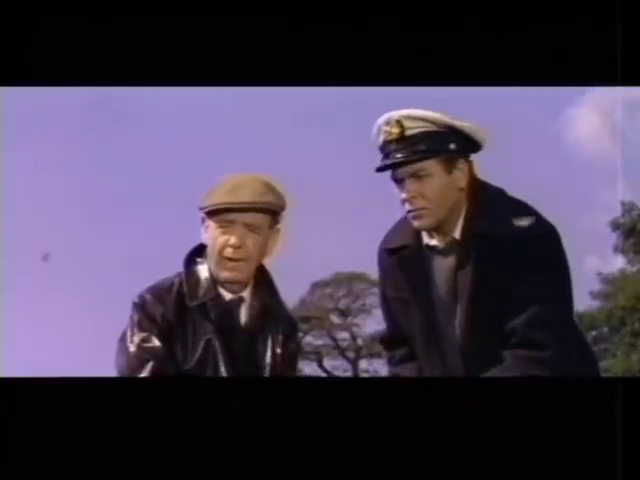



The Day of the Triffids (1962)
Film review #512
Directors: Steve Sekely, Freddie Francis
SYNOPSIS: After a meteor shower that is seen across the globe, nearly everybody on Earth is blinded by it. Billy Masen, a merchant navy officer, avoids being blinded as he has had his eyes bandaged up from an operation. He takes off his bandages to find he is one of the few people in the world who has not been blinded, and also that the meteor shower has released a strange plant called triffids that are multiplying rapidly, and attacking people…
THOUGHTS/ANALYSIS: The Day of the Triffids is a 1962 sci-fi horror film based on the novel of the same name by John Wyndham. The film begins with introducing Bill Masen, A merchant navy officer, who is resting in hospital after an eye operation. While his eyes are covered up in bandages, a meteor shower seen across the world blinds almost everybody on Earth. Bill is unaffected because of the bandages covering his eyes, and wakes up the next morning to remove his bandages and find that everyone else around him has gone blind. This has caused not only to society to break down and all services and communications to cease, but also the meteors have released a strange species of plant called Triffids that can move and attack people. The film is a balance between a post-apocalyptic survival film, and also a classic B-movie monster movie, and for most part, it is balanced quite well. The tone of the film remains serious and desperate, without too much of that low-budget b-movie tone undoing it. There’s also a good balance between the two sides of the story presented to us, with Bill and those he meets trying to survive in the world, and scientists Tom and Karen Goodwin, isolated from the world at a remote lighthouse, try to investigate the triffids and find a way to stop them, separating the explanations and exposition from the drama-heavy story of Bill and those around him trying to survive. It should be noted though, that the film is not a particularly faithful adaptation of the book, as it moves some of the settings and omits some characters. There are other adaptations that are more faithful, so you may want to look there if you want something closer to the book.
Apart from the good balance of characters and tone, there’s also some good shots and settings that set the scene rather well. Shots of the streets of London and Paris deserted are rather striking, and the scenes exploring the fallout of everybody being blind, from mass panic and planes being unable to land gives us some dramatic moments with big consequences, but the main focus is on Bill and his group’s isolated struggle for survival. The triffids themselves look like a b-movie creature, but manage to be quite menacing and threatening at some points, particularly in one scene where you see a hoard of them amassing behind an electric fence.
The ending is perhaps the weakest part of the film, and again something that deviates from the original novel: it turns out that the triffids dissolve in seawater…and that’s it. The world is saved apparently. It’s an ending twist similar to The War of the Worlds, which released a film adaptation in 19053, and had the invading Martians unable to survive in the earth’s atmosphere outside of their protective environments. We’re not given an insight into how the world is meant to carry on with nearly everybody blinded, but I suppose Bill’s story has a solid ending with him and his cohort reaching safety. One other notable aspect of the ending is that some survivors who have been trapped in a submarine emerge, and…go to a church to give thanks for their survival. This is an odd choice for an ending, particularly because Wyndham was not a religious person, but a a fair few of these sci-fi horror films (The Day the Earth Stood Still springs to mind), where ultimately God and religion are shown to still be all-powerful in the face of science. It’s an ending that comes out of nowhere and isn’t necessary, but is not uncommon in films of this era. Overall, The Day of the Triffids has some good aspects to it: it benefits from having the structure of the novel to balance out the different aspects of the film, but becomes a lot weaker when it deviates from it. The Triffids are a fairly terrifying monster in particular scenes, and are more memorable than a lot of monsters, but their undoing is a little contrived and uninspired. A good example of a b-movie monster flick, with some post-apocalyptic elements that heighten the drama.
-
#511 – Killdozer (1974)
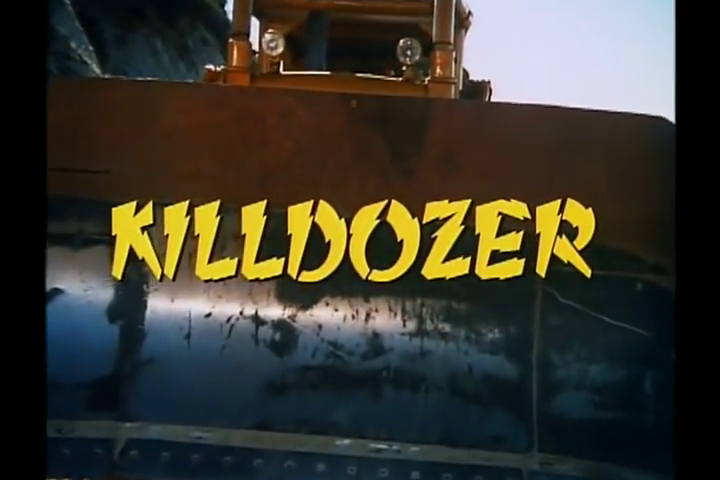








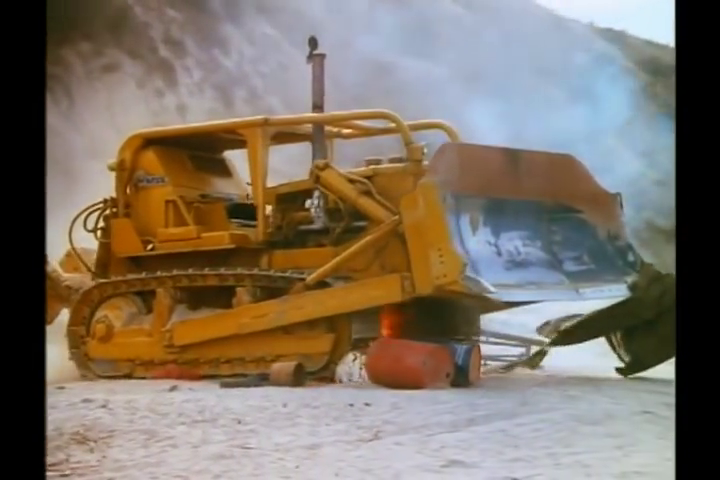
Killdozer (1974)
Film review #511
Director: Jerry London
SYNOPSIS: At a remote construction site, a group of workers uncover a strange meteorite while using a bulldozer. This vehicle becomes possessed by the strange energy from the rock, and begins killing off the workmen at the site. The survivors must find a way to survive and put a stop to the rampaging vehicle before it bulldozes them as well…
THOUGHTS/ANALYSIS: Killdozer is a 1974 TV movie which, as the title suggests, is about a killer bulldozer. The film is a typical sci-fi horror film, with the less typical set-up of the big bad being a construction vehicle. Nevertheless, the plot unfolds as you would expect, with the bulldozer killing off the workmen at the site one by one as they try to work out what is going on and how to survive. The premise of the villain being a bulldozer is the only unique aspect of the film, and as you might imagine, it brings with it a whole host of implausibility about the whole set-up. The film is based on a remote island with only one two-way radio, so when it is destroyed by the bulldozer, they have no means to communicating with anyone (back in 1974 when nobody had mobile phones…). This isn’t the really big problem though: it just seems like a killer bulldozer would not be that much of a threat, given both how slow it moves, and also that it would not be able to get up large inclines. As you might suspect, the characters don’t really seem to consider this, and keep meeting their end with the bulldozer slowly ploughing into them. The film does try to justify it’s decisions and emphasise the futility of the situation, but in a film about a killer bulldozer, you’re never going to be completely convinced of the severity of the entire situation. Then again, it’s a very no-frills production, with a lack of special effects that gives it a gritty rootedness, which makes it in a roundabout way, more believable.
The characters are a group of pretty down-to-earth characters: being a group of construction workers, they all have a similar outlook and mindset. As such they don’t all have distinct personalities on a trope-per-character basis, but while they all overlap, that makes sense given they all have the same job and are all put into the same situation. Clint Walker and Robert Urich as the leads have just enough differences in their personalities to make a dynamic, conflicting relationship form between the two of them, but that’s all the character development you really get. As you might expect, the bulldozer itself doesn’t have much of a character because…it’s a bulldozer. That’s not to say you can’t give murderous vehicles personality and make them scary, because there are quite a films that have done so (albeit after this film was released). I think if there was more of a logic to how the bulldozer was operating, or why it was running amok it would make it more interesting.
One of the more surprising aspects of the film is that it is actually based on a short novel released in 1944, and the basis for a comic adaptation released in the same year as the film. What is also interesting is that the writer of the novel, Theodore Sturgeon, did the re-write of the film too. There’s a lot of changes from the novel, such as being set in the “present” rather than the “present” of the novel in WWII. Being a TV movie, the budget probably wouldn’t have been able to account for the origins of the energy that possesses the bulldozer; which in the original novel was a remnant of a weapon used by an alien race against the ancient race that lived on the Earth (the comic also explored this a little too). In a way, this actually helps the film, insofar as it keeps the film grounded and avoids any fantastical or ridiculous sci-fi elements that open it up to mockery or make it even more unbelievable. Killdozer is about what you would expect from a TV movie: a low budget production that is nothing particularly ground-breaking. This down-to-earth production actually helps the film rather than hinders it though, and sharpens focus on the characters and this bizarre situation they find themselves in. The whole premise is still absurd, and there’s definitely better “killer vehicle” movies out there, but this one works well with what it has.
-
#510 – Trancers 6 (2002)








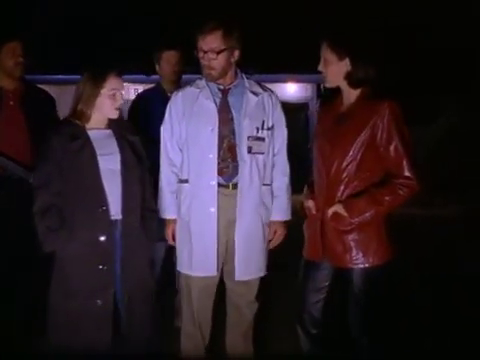

Trancers 6 (2002)
Film review #509
Director: Jay Woefel
SYNOPSIS: Trancer hunter Jack Deth is once again sent “down the line” back in time to hunt down a new Trancer threat. He ends up in the body of his daughter, whose lifestyle certainly doesn’t fit with his own. In this new body and life, Deth must hunt down the Trancer threat and put a stop to it before his daughter is killed and he is wiped from existence.
THOUGHTS/ANALYSIS: Trancers 6 is a 2002 sci-fi film and the sixth film in the Trancers film series. In a return to the original premise of the films, Trancer hunter Jack Deth is sent back in time to inhabit the body of his daughter in the 21st century, to find and counter a new Trancer threat before they can kill his daughter and erase his existence. After the weird fantasy adventure of Trancers 4 and 5, this one returns to a more simple sci-fi action film. The absence of Tim Thomerson as Jack Deth in this film removes the only redeeming aspect of this film franchise: his caricature of cheesy action heroes was so ridiculous that it would be entertaining. His appearances in this film are limited to archive footage from previous films, and a stunt double playing his barely visible body strapped to a table in the future. Instead, we get Jack inhabiting his daughter Joanne…who is also his great-great grandmother, managing to create some sort of paradox or another, but this is glossed over, as the film doesn’t really focus on details in general: it’s straightforward, to the point, but that lack of detail really slows the film down after the first act, where it becomes apparent the film has very little substance. The film manages to feel both like a low-budget film from both the 80′s and the early 2000′s at the same time, which I suppose makes sense, but being released eighteen years after the first film, there’s very little progress to show in terms of story, production, lore, or design.
Joanne (Jo) is basically everything Jack Deth isn’t: a tee-total, vegan, meek nerd with a dull career. The majority of the humour in this film basically derives from Jack Deth being his foul-mouthed, smoking, misogynistic self, retorting everything that is said to him with a cheesy or inappropriate one-liner. The film is very much a one-trick pony in this regard, but honestly, it retains it’s entertainment value throughout the film, and it is genuinely funny in parts by virtue of how purely cheesy it is. This has always been the Trancers films best aspect, and it is good to see that even without Thomserson, they are still able to pull it off. Zette Sullivan as Jo Deth manages to pull off Jack’s style of speech and deliveries pretty well, and you can really believe that Jack is inhabiting her body. The line delivery is a bit flat sometimes, but there’s definitely worse things about the film. The rest of the cast; from the supporting characters to the villains, really do not leave an impression. The new Trancer threat isn’t really explained after Jack supposedly wiped them all out in the previous films: apparently it has something to do with meteors and radiation or something, but as mentioned, the intricacies of the plot aren’t really the focus of the film.
Being a production by Full Moon Entertainment, you should expect a low-budget production, but this is bad even by their standards. The sets are limited to empty building, corridors, and some rural outdoors scene in the middle of nowhere. The special effects are really bad, but thankfully only used once when a guy is thrown out of a high-rise building, resulting in a hilariously bad effect. The gore and other effects are pretty standard, and are nothing too noteworthy; a lot of the production is very much what you would expect from these films, but there’s also a distinct lack of trying to do anything unique, and an added amateur-ness in the camera work, acting and locations. Trancers 6 is a bad film, there’s no escaping it: it is dull, poorly produced, and very threadbare on plot that it feels somewhat pointless. Despite all of that though, it still manages to recapture the absurd, over-the-top character of Jack Deth even without Thomserson’s portrayal, and the twist of putting him into a young woman’s body is just different enough to provide new entertainment value in the whole set-up. The film definitely relies on this sole gag to carry the whole film, but if you’ve made it through the previous Trancers films and got some laughs and entertainment from them, you can probably get a little more out of this last one.
-
#509 – Godmonster of Indian Flats







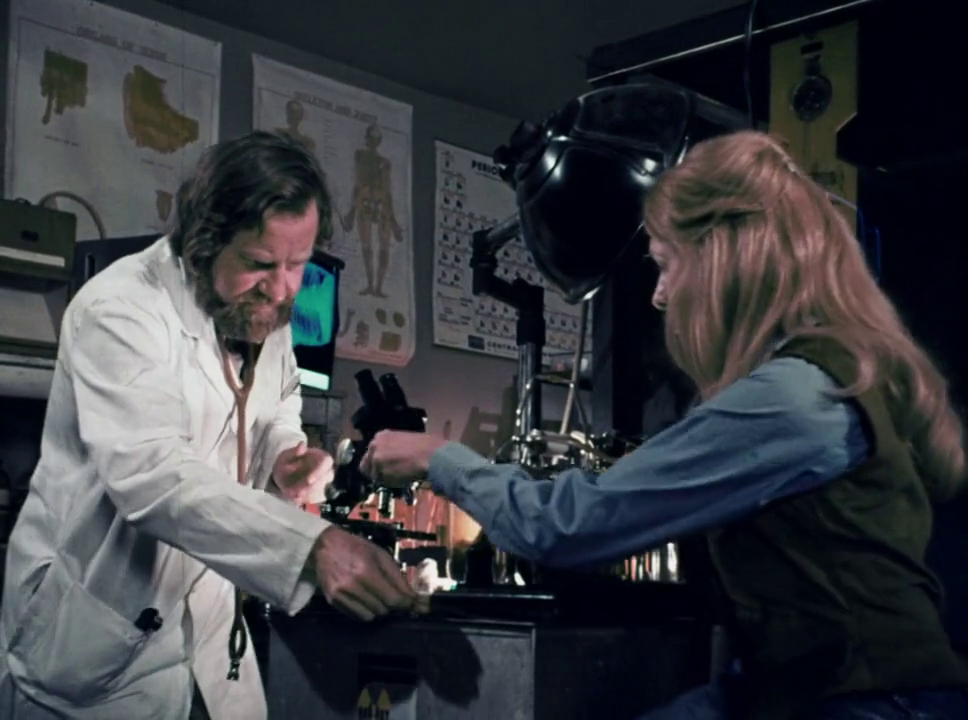



Godmonster of Indian Flats (1973)
Film review #509
Director: Fredric Hobbs
SYNOPSIS: Following a big gambling win and passing out in a drunken stupor, rancher Eddie finds a strange, large embryo on his ranch. Professor Clemens takes the embryo to his laboratory for study. meanwhile, a businessman attempts to buy property in the town for mining development, but the mayor and the secret society of the town have other ideas, as they wish to preserve the legacy of their town as an “old west” place for tourism…
THOUGHTS/ANALYSIS: Godmonster of Indian Flats is a 1973 western horror film. In the opening, we see rancher Eddie winning big on the slots and getting taken for a ride by some of the townsfolk. He is taken back home and awakens the next morning to find a large embryo. Local anthropologist Professor Clemens and his research assistant Mariposa take the embryo to incubate it, where they believe it to be the monster that has been talked about in local legends. Meanwhile, a wealthy businessman named Barnstable is trying to buy land in town to get the mines operational again, coming up against the mayor who wants to preserve the “old west” feel of the town to keep tourists coming in. These two main threads of the story are the main issue of the film, mainly because they develop almost separately from each other, only really crossing over at the end. If you want to see a “weird west” type of film consisting of a Western combined with other genres, you don’t really get that because the genres stay very separate for the vast majority of the film. It’s really difficult to figure out what is going on in the story or what the motivations for the characters are when there are all these unconnected things going on. The film sets itself out as some kind of western horror (judging by the title), but most of the film sees the monster stuck in a laboratory, and instead focuses on the goings on of this dusty town. There’s definitely a lot of effort put into creating the atmosphere of an old west frontier town in the Southern U.S., and it does set it up fairly well in the beginning, but when it comes to building a set-up and characters around it, there’s very little cohesion and direction to drive the film.
There’s plenty of characters that are laid out and the setting is constantly built-up through the expansive shots of the landscape, and the dusty, isolated town. There’s definitely a vision in that regard, but there’s so many strange decisions with respect to the story that it becomes a series of bizarre events that are consistently inconsistent. The scene with the funeral of a dog whose death was staged to make Barnstaple look bad is just so absurd I don’t know how you’re supposed to take it seriously. The acting is also pretty dire so as to alienate the viewer from the story even further. The monster itself we see in bits and pieces until the end of the film, where we are treated to the form of a deformed, mutant sheep of some sort. Trying to make a sheep look threatening seems like a fruitless endeavour, but they certainly tried regardless. It always, however, looks like a sheep, and so isn’t that scary or horrifying.
There’s definitely some arguments for it being a “so bad it’s good” film, with the pure weirdness in the story and it’s random jumps in tone that come out of nowhere. In this way, it is certainly entertaining and not boring, but you will be constantly wondering how all this fits together. I feel like there’s definitely a vision that grounded the production of this film, specifically in brining this old west town and it’s population and culture to life, but anything on top of that, from the story, the characters, and the whole monster thing are so convoluted that it’s difficult to take it seriously. Overall, Godmonster of Indian Flats is just plain weird: it has all of these things it wants to do, but no idea how to bring them together. The parts where the film tries to take itself seriously are offset by the incomprehensible plot, unimaginative characters, and flat acting. Maybe some people would describe it as “so bad it’s good”, and there are certainly some points where that is the case, but on the whole, I think it just falls short of having that entertainment value.